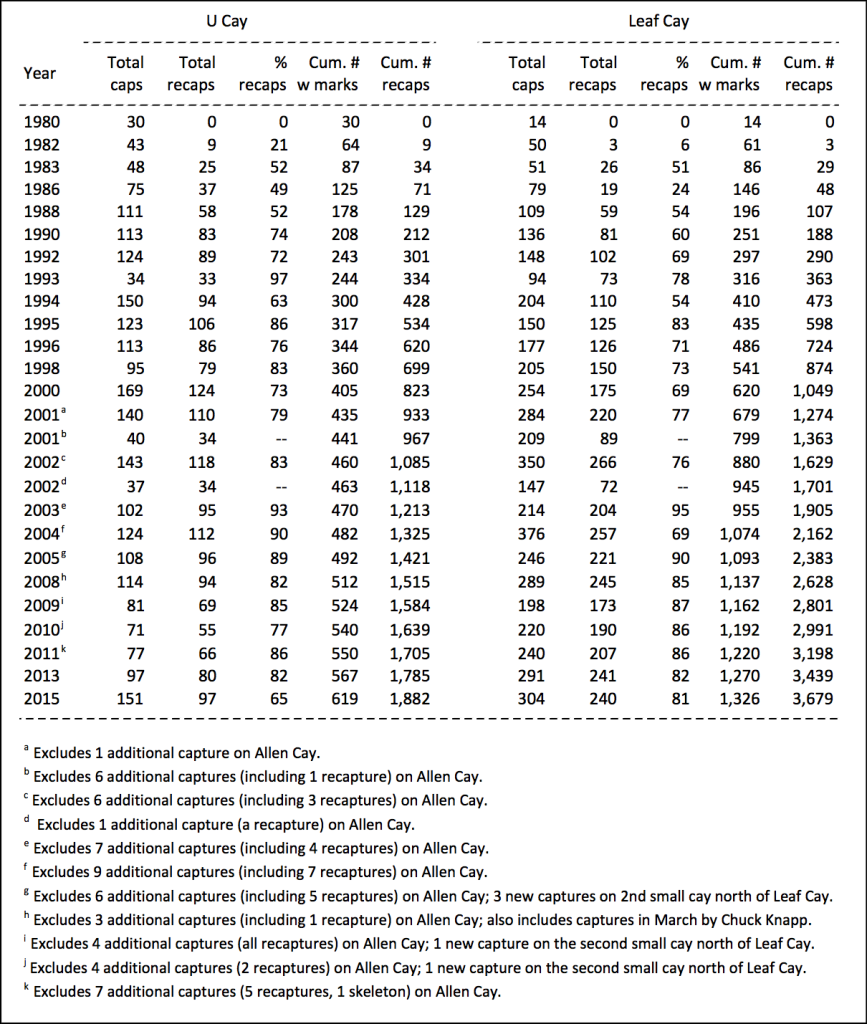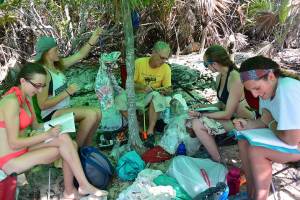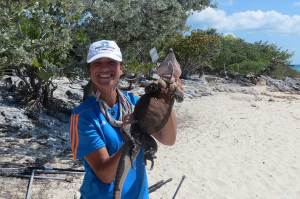Allen Cays Iguana Research Update (Cyclura cychlura inornata)
16 to 22 May 2015
Dr. John B. Iverson
Dept. of Biology, Earlham College,
Richmond, Indiana USA
Allen Cays Overview
This was the 35th year of our studies of the Allen Cays Iguana in The Bahamas. With a team of six undergraduates each (plus five total faculty) from Earlham College and Denison University, we captured 304 iguanas (81% of them recaptures) on Leaf Cay, and 151 on U Cay (65% recaptures). We have now accumulated over 7,500 iguana captures on these two cays over our 35-year study! See Table 1.

Table 1. Recapture information by year for Allen Cays Iguanas. Abbreviations are: caps (captures), recaps (recaptures), and Cum (cumulative). Total number of captures for U Cay is 2,501 (619 + 1,882) lizards, and for Leaf Cay it is 5,005 (1,326 + 3,679). All trips in 1980 through 2000 were in mid-March. Trips in 2001 and 2002 were in mid-May and mid-June to mid-July. Censuses in 2003-2015 were also in mid-May.
Early in our study in the 1980s, sex ratios on these cays were biased toward males by a ratio of two to one. Over the subsequent three decades they steadily moved toward the expected one-to-one ratio, but are now moving toward female biased ratios. For example, the sex ratio of captured iguanas on Leaf Cay this year (126 males to 156 females) was nearly statistically biased toward females (p = 0.07), compared to 133 males to 135 females in 2013, 102 to 101 in 2011, and 92 to 102 in 2010. In addition, the sex ratio of captures on U Cay has been significantly skewed toward females for several years (54 males to 91 females this year, 37 to 52 in 2013, 28 to 46 in 2011, and 20 to 49 in 2010). We continue to believe that these latter biases are in part due to the unexplained disappearance of most of the large, relatively tame males that came to the main beaches to be fed by tourists in recent years. We suspect that the large iguanas have been killed or removed by humans, either for food, the pet trade, or to reduce physical risk to ecotourists feeding them. This disappearance is reflected in Figure 1 and shows that the average size of the largest ten males and ten females from Leaf and U Cays has declined significantly (p ≤ 0.01) over the last 20 years.

Figure 1. The frequency of Allen Cays Iguanas with tail breaks remains low overall (6.4% on Leaf Cay, 7.4% on U Cay), but rates were higher for females on Leaf Cay (9.0% for females, 3.2% in males), but higher in males on U Cay (9.3% vs 6.6%). We will continue to monitor this, but we believe this variation is just sampling bias. We do not know the causes of tail breaks (e.g., depredation attempts, sexual aggression). Regression lines are statistically significant at P < 0.01.
The attraction of iguanas to the feeding beach on Leaf Cay continues to increase with the increased human traffic (i.e., feeding). This year, despite our active attempts to survey the entire island, 56% of all Leaf Cay captures were made on that main feeding beach, which represents only about 5% of the total island area. Furthermore, we examined growth rates over the past 20 years of iguanas from the west (fed) side of Leaf Cay versus those from the east (unfed) side of Leaf Cay versus those from U Cay (fed, but less so than Leaf Cay). Not surprisingly, we found the fastest growth on western Leaf Cay, followed by that on U Cay, with the slowest growth on the east side of Leaf Cay where iguanas are never fed by humans. These results provide one more increasingly significant effect of humans on these iguanas.

Processing team on Leaf Cay. Photo by Lynne Pieper.
We also noticed that Leaf Cay iguanas were shedding large flakes of skin at a significantly higher frequency (35%) than those on U Cay (22%). Whether this difference is related to the elevated levels of supplemental feeding by tourists on Leaf Cay (and concomitant increased growth rates) is uncertain, but is our best hypothesis.
New Research
University of San Diego Master’s student Kristen Richardson has nearly completed her research on the use of stable isotopes in the tissue samples of Allen Cays Iguanas to determine their dietary history [ratios of isotopes in an animal’s tissues reflect the ratios of isotopes in the organisms they have eaten in the past]. Her preliminary data indicate that iguanas on all islands (including Allen Cay where the gigantic iguanas live) are primarily herbivorous. However, the Allen Cay food web is significantly enriched with nitrogen, presumably from the guano and carcasses from the colony of nesting Audubon’s Shearwaters there. It appears that the plants on Allen Cay have higher nitrogen content, which may be driving the increased body size of the iguanas through higher food quality. Kristen intends to finish her thesis by the end of the summer.
PIT Tags
This year we implanted an additional 90 microchip (PIT) tags in iguanas, and have now PIT tagged a total of 1,009 lizards in the Allen Cays (Table 2). We had one PIT tag failure this year, but the failure rate has been quite low over our 21 years of using them, as has been the failure rate of toe clips due to natural toe loss. We will continue to PIT tag as many subadults and adults as possible each year as funds allow ($8 per tag), because the redundancy of using both methods simultaneously ensures the positive identification of every iguana so marked. We found several interesting instances of the migration of a PIT tag from its original subcutaneous injection site anterior to the left hip. In three of those cases, the migrated tag was located mid-ventrally, in the right abdominal area, and in one it was found inside the base of the tail!

Table 2. Tally of PIT (passive integrated transponder) tags deployed and their success rates for Allen Cays Iguanas. Abbreviations are Recaps (recaptured lizards), Cum (cumulative), True tag failures (tags palpable under skin, but no signal), and Other tag failures (tags not palpable and no signal). Data for 2001-15 are for May captures only.
Climate Patterns
Unfortunately, our rain gauge was inoperative over the last year. Hence, we were unable to quantify the abnormally wet spring experienced by The Bahamas. The vegetation was more luxuriant in May than we had ever seen it, no doubt reflecting the high rainfall in the Allen Cays. This pattern of excess rainfall during the spring dry season was similar to that in 2012.

Table 3. Monthly rainfall (in inches) recorded in digital logger on Leaf Cay in the Allen Cays from 18 May 2008 to 18 May 2009, 19 May 2010 to 19 March 2011, 15 May 2011 to 11 May 2012, 11 May 2012 to 19 March 2013, and 15 May 2014 to 13 April 2014. Note the unusual amounts indicated in bold.
Allen Cay Renovation Project Update
We only had time to send a small team to Allen Cay for a half day this year, to follow up on the impacts of the mouse eradication in 2012. They walked the entire the island and neither saw nor heard any iguanas, but did see tracks on the landing beach as well as on the artificial nesting site north of the landing beach. We intend to do a more thorough survey in 2016 and also create more new potential iguana nest sites by filling another sink hole with beach sand. Also, a few more iguanas that were translocated from Allen Cay to Flat Rock Reef Cay during the Allen Cay mouse eradication have not yet been returned to Allen Cay. It is our intention to capture and return them in May of 2016.
Future Plans
We plan a full survey of the Allen Cays in both May of 2016 and May of 2017. Priorities in 2016 will include thorough surveys of Flat Rock Reef and Allens Cays, shorter surveys of Leaf and U Cays, and a much more intensive survey than usual of the introduced population of Acklins Iguanas (Cyclura rileyi) on Bush Hill Cay that we have also been studying since 2002.
Acknowledgments. This work would not have been possible without the continued support by Mrs. Sandra Buckner, The Bahamas National Trust, The Bahamas Environment Science and Technology (BEST) Commission, The Exuma Cays Land and Sea Park, The Bahamas Department of Agriculture, Powerboat Adventures, 7 C’s Charters, John Alford and Barbara Thompson (owners of Leaf Cay), and Greg Cottis (owner of U Cay). The financial support of the International Iguana Foundation, ZooAtlanta, the late Dr. Ned and Sally Test, the Cope Museum Fund of Earlham College, and 140 different Earlham College students (and eight faculty) and 18 Denison University students (and three faculty) over the past 35 years is also greatly appreciated.










